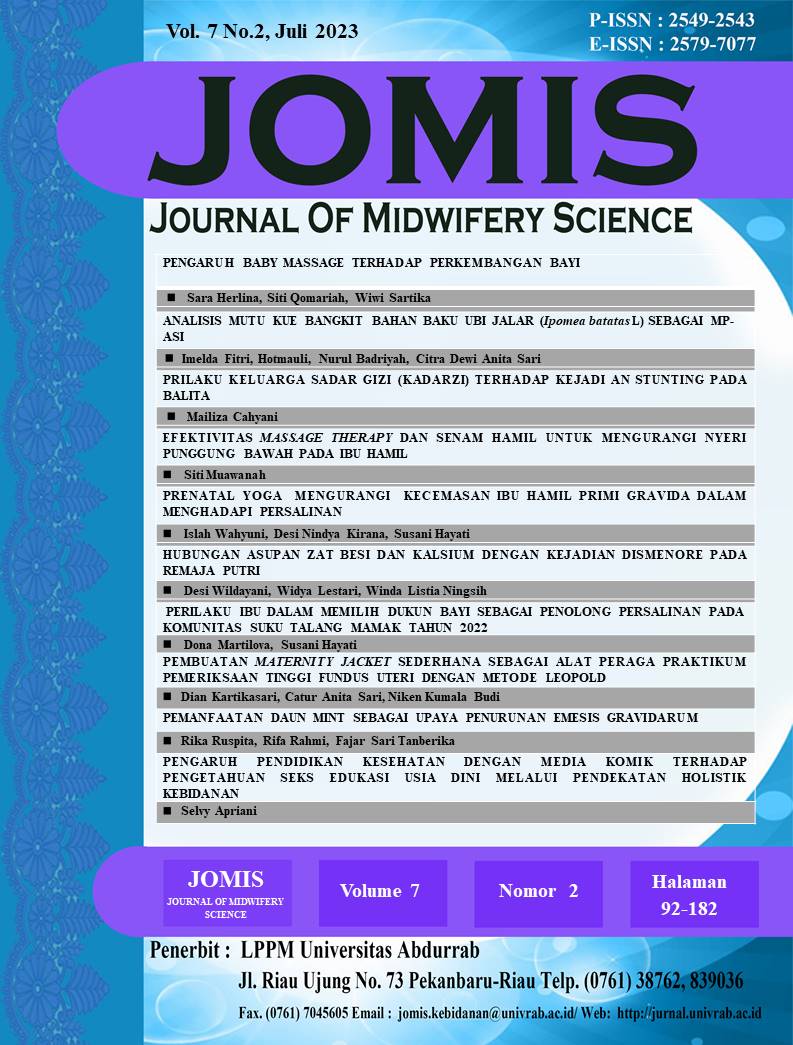PEMANFAATAN DAUN MINT SEBAGAI UPAYA PENURUNAN EMESIS GRAVIDARUM
Abstract
Although complaints of nausea, vomiting are considered normal for pregnant women and do not harm the fetus in the womb. However, if the frequency of nausea and vomiting is excessive, you still have to watch out for it. Nausea followed by severe vomiting can be a sign of a disturbance in pregnancy and nausea and vomiting often occurs in pregnancy, around 60% - 70% of pregnant women experience nausea and vomiting, especially in the first trimester. The aim of this research was to find out the effectiveness of using mint leaves as an effort to reduce emesis gravidarum. This research method uses quantitative methods with pre-experiments using a one group pretest-posttest design. The research population was first trimester pregnant women who experienced emesis gravidarum at the Rejosari Pekanbaru Health Center with a sample size of 31 respondents with a sampling technique using purposive sampling. Based on the univariate results, it was found that the distribution of emesis gravidarum before administration of mint leaves showed at most degree 2 with a total of 26 (83.9%) respondents. Bivariate analysis used the Parametric Test using the Dependent T Test (Paired T Test) with an average frequency of emesis gravidarum before administration of mint leaves was 7.10 times with a standard deviation of 2.103 times. At the frequency of emesis gravidarum after administration of mint leaves, the average emesis was 4.26 times with a standard deviation of 1.527 times. It can be seen that the mean difference before and after giving mint leaves is 2.84 times with a standard deviation of 0.576 times. The statistical test results obtained a value of 0.000, so it can be concluded that there is a significant difference between before and after giving mint leaves.
Copyright (c) 2023 JOMIS : Journal of midwifery scinece

This work is licensed under a Creative Commons Attribution-NonCommercial-ShareAlike 4.0 International License.
1. Copyright of all journal manuscripts is held by the JOMIS : Journal of midwifery scinece
2. Formal legal provisions to access digital articles of electronic journal are subject to the provision of the Creative Commons Attribution-ShareAlike license (CC BY-NC-SA), which means that JOMIS : Journal of midwifery scinece is rightful to keep, transfer media/format, manage in the form of databases, maintain, and publish articles.
3. Published manuscripts both printed and electronic are open access for educational, research, and library purposes. Additionally, the editorial board is not responsible for any violations of copyright law.
licensed under a Creative Commons Attribution-ShareAlike 4.0 International License.
 PDF
PDF
 Abstract views: 860
Abstract views: 860
 downloads: 1183
downloads: 1183

 :
:





